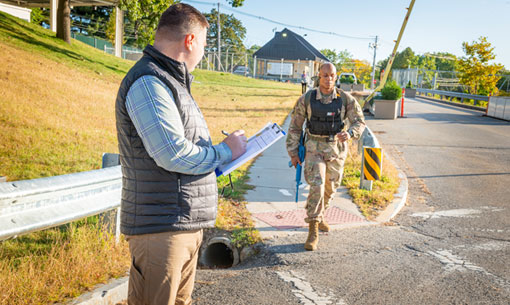Natick Facilities
Click below for more information about each facility at USARIEM.
Five biophysical evaluation chambers containing fully sensored, articulated, moveable copper manikins, and other metallic models of feet and hands are available for testing of thermal and vapor-resistance values of clothing.
The Doriot Climatic Chambers are two, 60-feet long, 11-feet high, 15-feet wide chambers that are owned and operated by NSRDEC. The Doriot Climatic Chambers are among the largest and most sophisticated environmental test chambers in the world, capable of simulating environmental conditions ranging from the arctic to the tropics. The chambers contain 5-person treadmills that are used to assess the effects of ambient temperature on the physical performance and physiological responses of Soldiers, and can accommodate up to 25 Soldiers for tests on built-in treadmills.
USARIEM's Military Nutrition Division conducts nutritional research using a Metabolic Kitchen located in the Doriot Climatic Chambers at the Natick Soldier Systems Center. The metabolic kitchen is 288 square feet and has cooling, freezing, heating and bulk storage capabilities. Our Research Dietitians provide study participants with meals that are prepared in accordance with IRB approved protocols and specially designed to meet the dietary needs and specifications of the research protocol. The food items prepared and served in the metabolic kitchen include complete study menus that are packed and provided to feed participants in their free-living environments or in-house during testing, and supplemental items such as snacks and beverages used in protocol interventions. Many protocols within the Military Nutrition Division utilize ration items from the Meals, Ready to Eat (MREs) in addition to commercially available foods. Controlled diets are planned and managed using diet analysis software as well as the Ration Analysis database, allowing for accuracy in the nutrient intake data collected. Our facility allows USARIEM researchers to assess various feeding regimens and nutrient interventions in a tightly controlled setting with the ultimate goal of improving Warfighter health and optimizing both physical and cognitive performance under various environmental conditions.
This facility simulates global atmospheric conditions by reducing ambient barometric pressure using vacuum pumps in combination with precise manipulation and control of temperature and relative humidity. The facility consists of a large (9.7 x 20.6 ft) and a small (9 x 12 ft) chamber, both connected to an airlock. It also includes a shower, toilet, and running water for sustained multiday periods of operation. The chambers can be controlled for pressure (sea level to 9,000 meters), temperature (-32°C to 43°C), and relative humidity (20% to 80%).
USARIEM has environmental and biophysical evaluation chambers of various sizes that can be controlled for temperature (-10°C to 50°C), relative humidity, and wind speed provide ample research space for testing. Eight environmental chambers are available for use with human research volunteers and animal models.
This facility simulates cold and hot environments by changing water temperature in a 10,000 gallon concrete vessel. The tank is 10 ft long x 10 ft wide x 14 ft deep. The facility provides the ability to test human performance while exercising on a single underwater walking treadmill or with two cycle ergometers while sitting on accompanying bolted-down stainless steel chairs. Water temperature can be controlled in a range of 5°C to 50°C.
This facility is for research into adaptations that occur in healthy bone as the result of strenuous physical training. It contains the most advanced technology available to study parameters of bone quality, specializing in analyses of the lower extremities. Laboratory equipment includes peripheral quantitative computed tomography, dual x-ray absorptiometry, and tibial ultrasound. Additional equipment and methods, which include an isokinetic dynamometry and dynamic gait analysis, is available to assess muscle performance variables associated with bone health.
This 800 square foot facility houses the EST 2000, a widely used weapon engagement simulator that can mimic the ballistic characteristics of 25 different weapons. New marksmanship scenarios can be created. The enhanced capabilities of the EST 2000 make it possible to test several measurement paradigms: Marksmanship, Shoot—Don't Shoot, Vigilance (or Information Overload), Discrimination of Friend versus Foe, and Motor Steadiness under varied situations. These include workload (information or physical), simulated sustained operations, fragmented and inadequate sleep, physiological or metabolic disruption, fatigue (central systemic or localized muscle), and therapeutic strategies.
This facility provides testing stations for computer-based assessment of cognitive and behavioral Warfighter performance. This 500 square foot configurable space can accommodate up to 24 test volunteers with viewing windows for experimenter observation. Operational stressors that can be studied include extended mental alertness, simultaneous task performance, and nutritional and pharmacological interventions. Laboratory equipment enables the assessment of physiological state through eye tracking and trans-cranial Doppler brain blood flow systems.
This facility consists of a fully equipped 5,000 square foot biomechanics research laboratory with a 12 camera Qualysis infrared video motion analysis system. It also contains a unique patented dual-force platform treadmill that measures x, y, and z forces and torques on individual feet during walking. There are also six portable Myomonitor EMG systems to measure muscle nerve activity, as well as metabolic carts to measure oxygen consumption to determine locomotion efficiency.














